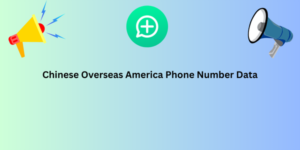A sales funnel is also called a conversion funnel or a purchase funnel. It is a model that illustrates the sales process from the moment a brand first comes into contact with a potential customer chinese overseas america phone number data until the transaction is completed . It can be presented as a series of stages that a customer goes through to reach their goal, i.e. purchase (or other form of conversion). From initial interest in a product or service, through considering the offer, to making a purchase decision.
Why is this model called a funnel? Each stage of the funnel reduces the number of potential customers who move on to the next. Visually, it resembles the shape of a tapering tube.
sales funnel operation
Stages of a classic purchasing funnel
There are many potential customers at the first stages, but only a specific group of people reaches the last one. It is worth adding that the sales funnel looks different depending on the size of the company, the nature of its products, the industry (including the distinction between B2B and B2C) and other factors.
Awareness Stage: Build Interest
The first stage of the sales funnel is building awareness. At this point, the potential customer learns about the existence of your product or service. This is an important stage because without awareness of the product/service, no other marketing activities will be possible to implement.
How to build awareness in the early stages of the sales funnel? Tools such as online advertising, social media, content marketing, and PR campaigns are used to generate interest and attract attention.

Also read: What is sales lead management?
At the initial stage of the sales funnel, call center tools will also prove useful. Especially in terms of lead generation and cold calling . Consultants can inform potential customers about products or services and build brand awareness. Cold mailing, i.e. sending emails to new potential customers, can also prove useful at this stage.
Reflection Stage: Educate and Persuade
If you have successfully interested a potential customer and your brand (and its products/services) are already in their minds, it is time for the consideration stage. The customer considers various options, often comparing your offer with the competition.
This is the stage where it is important to provide valuable information . Information that will help the customer better understand the product and its advantages over competitors' products. Webinars, e-books, case studies, as well as product demos or free samples can help with this. In most industries, running a blog with how-to articles that solve users' problems and answer their questions or concerns will also work .
When a potential customer is in the consideration stage, call center tools such as product hotlines, callback (on-demand contact from a website), on-site chat, or customer service center (CSC) can be very useful for conversion.
Decision Stage: Streamline the Buying Process
The final step is the decision to purchase. To make the conversion possible, it is important to streamline the entire purchasing process, making it as simple and time-consuming as possible. This can include optimizing the shopping cart page on the website, providing convenient payment methods, and fast and hassle-free customer service.
Encouraging action through various forms of promotion or personalized offers can also significantly increase conversion. At this stage, the potential customer already has all the information about the product, is interested in buying, but may need an impulse to act . Then, for example, you can arouse a need related to the product, indicate a temporary limitation of the offer or simply ensure friendly contact.
